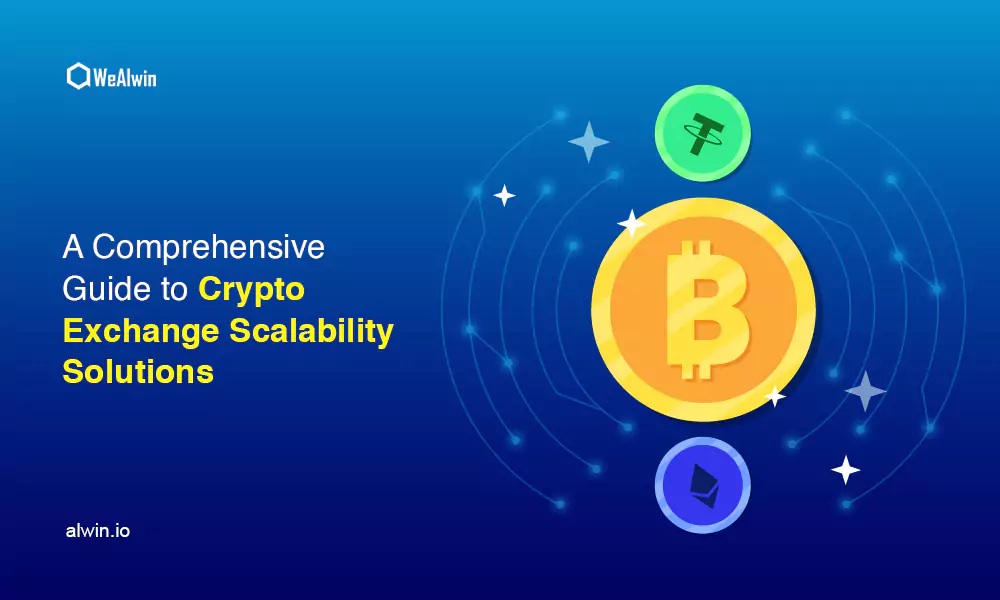Crypto exchanges cannot ignore the importance of scalability solutions. As blockchain networks continue to gain traction, the limitations of their base layers have become increasingly apparent, prompting the exploration of various scaling solutions.
Blockchain scalability is crucial for processing transactions at speeds comparable to traditional finance solutions like Visa and PayPal, ultimately enabling broader adoption and increased accessibility to cryptocurrency for users.
This is especially crucial in the implementation of smart contracts across industries like supply chains and gaming.
What is Scalability in Cryptocurrency Exchange?
Let's assume you are running a crypto exchange. It's a beginner one, nothing too fancy, and it’s managing quite well with around 1,000 visitors per week! and a trading volume of about $4,000 in 24 hours, for sure.
Your setup is not burdened, the servers are all cool, and the support team is having regular coffee breaks. Now let's say change gears, up your marketing game, maybe form some strategic alliances, or enter new markets.
Over time, evolve and grow. Along with this, you will face new complexities: have an eye on advanced traders, possibly even those big kahunas – institutional users!
You want an increase in trading volume. It's like a chain, and you need to scale your platform to make sure that it can handle this overload and high trading rate.
Challenges in Scaling a Cryptocurrency Exchange: Overcoming Obstacles
Scaling a crypto exchange can be challenging due to various factors. These include liquidity management, performance and scalability, security, regulatory compliance, and user support.

As the user base grows, maintaining adequate liquidity becomes essential to prevent order book fragmentation, reduced trading volume, and wider spreads.
A surge in trading activity can put a strain on the exchange's performance, leading to slow order processing and downtime.
As the exchange becomes more prominent, it becomes an increasingly attractive target for hackers, and security breaches can result in significant financial losses and harm to one's reputation.
With growth comes the need for stricter regulatory compliance, including Know Your Customer (KYC) and Anti-Money Laundering (AML) checks, which can be complex and resource-intensive.
Scaling also means handling a larger number of user inquiries, support tickets, and account verifications, which can be challenging to provide quality customer support under increased demand.
What Key Factors Make a Crypto Exchange Scalable?
1. Fast Servers
Having a quick web hosting service is unquestionably essential to the success of your organization. An extremely dependable web hosting provider helps to prevent outages.
A study by Portent mentioned that websites with load times between 0-4 seconds have great conversion rates. On the other hand; 0-2 seconds load times are golden when it comes to conversion rate!
You should choose a server provider with lightning-fast speed (0.5-2 seconds per loading time) and pretty much 24/7 uptime, say 99%.
Consider migrating to a cloud-based infrastructure such as Amazon Web Services (AWS) or Google Cloud Platform (GCP). Cloud services offer scalability, redundancy, and load-balancing capabilities to handle increased user activity.
2. Liquidity Partnerships
Form strategic partnerships with other exchanges or liquidity providers to share order books and access a broader pool of assets. These partnerships can enhance your platform's liquidity and offer a wider range of trading pairs.
3. Excellent Execution Rate
Whether having a high order execution rate is important or not! It depends on several factors.
Like, the type of order a trader has placed. If we are talking about limited orders, the execution rate might be less important.
But advanced traders, whether short-term or high-frequency traders will need a high order execution rate.
Now, if we consider Scalable Solutions’ execution rate, it's less than 500 microseconds. That’s the target if you are serious about business growth.
Utilize high-performance programming languages like Rust, or Go for critical components of your exchange. These languages are known for their efficiency and can help in managing the increased trading volume.
4. High Matching Engine Capacity
As one of the vital features, the matching engine of a great exchange will handle large transaction volumes, with no hiccups.
Low latency, awesome accuracy, high speed, and high throughputs are usually the key features of a potent matching engine, just so you are aware, high-performance matching engines can match 100,000 Transactions Per Second (TPS).
5. Advanced Trading Platform
Not just any trading platform will do, you need to attract the big players. So a basic exchange environment is not going to cut it.
PRO platforms support a long list of coins and trading pairs (like the platform by Scalable which handles 500+ digital assets, and 2500+ trading pairs).
Also, your clients can include in-demand assets quickly and easily (Attracting new users becomes easy, probably). It will take 1-3 days to list a coin or token and 2-4 weeks for blockchain integrations.
Talking about platform functionality, well, apart from spot trading it should include margin and futures trading, among other features like staking.
Also, you will have to offer API integration for Efficient high-frequency algorithmic trading for advanced users. APIs can also be a boon for professional clients who are already trading traditional assets and now want to add crypto as their offer.
6. Enhanced Security Measures
Continuously update and enhance your security measures, including multi-signature wallets, cold storage, and regular security audits. Security should be a top priority as your exchange scales.
Invest in robust Distributed Denial of Service (DDoS) protection to mitigate the impact of attacks on your exchange. A strong DDoS protection system can ensure high availability.
7. Superior Customer Support
Support service is yet another awful feature of a scalable crypto exchange. You need a team that knows the product inside out, is a quick responder, and is extremely respectful, not only proactive but also helpful.
Consult with our business experts to Know more about the Scalability of your Crypto Exchange Platform! Chat with us on WhatsApp
Enhance your customer support infrastructure with chatbots, ticketing systems, and a comprehensive knowledge base. These tools can handle a higher volume of user inquiries efficiently.
Educate your users about security best practices to reduce the risk of security breaches and fraud. An informed user base can contribute to a safer trading environment.
Enhanced Layer 2 Scaling Solutions for Crypto Exchange
Popular blockchains like Ethereum can get slow and expensive during busy times, causing issues for cryptocurrency exchanges. Layer 2 (L2) scaling solutions help by processing transactions off the main chain, improving efficiency. Layer 2 solutions mainly focus on directing the majority of transactions away from the mainnet.
These are extra protocols that make existing blockchains work better. They increase transaction speed by doing most transactions off-chain and only putting the final result on the main chain. This reduces congestion, speeds up transactions, and reduces gas fees, improving overall blockchain performance.
1. Rollups
Rollups process transactions off-chain and then submit a compressed version to the main blockchain. Roll Ups come in two primary varieties: optimistic and zk-rollups.
| Optimistic Rollup |
ZK-Rollup |
| Optimistic Rollup processes transactions off-chain and submits a summary or proof of transactions to the main blockchain |
ZK-Rollup uses zero-knowledge (zk) proofs for concise validation of transactions without revealing details. |
| Assumes submitted transactions are valid unless proven otherwise on-chain Verification occurs only during disputes |
Provides enhanced privacy and scalability compared to Optimistic Rollups. |
| Celebrated flexibility may result in extended settlement times in cases of disputes |
Efficient verification on the main chain involves confirming the proof's validity. |
| Examples: Optimism and Arbitrum |
Examples: Polygon Hermez and zkSync. |
2. Sidechains
Sidechains are an independent layer 2 scaling solution, operating separately from the main blockchain.
They facilitate the off-chain execution of smart contracts and transactions, enhancing scalability and reducing congestion.
Connected to the main blockchain through a two-way bridge, sidechains enable faster and lower-cost transactions.

Users can transfer assets seamlessly from the main chain to the sidechain, improving overall scalability by processing transactions off-chain and allowing experimentation with different consensus features without impacting the main chain.
3. Sharding
Sharding is a method of partitioning the data and transactions on a blockchain into smaller, more manageable parts called "shards."
Sharding has been used by projects including QuarkChain, Ethereum, Cardano, Harmony, and Zilliqa to solve scaling problems.

Each shard processes its own set of transactions, which can help improve the scalability of the blockchain by allowing multiple transactions to be processed in parallel.
4. Hard Fork
A hard fork is a significant and intentional divergence or split in a blockchain's protocol, resulting in two separate and incompatible chains.
It is a software upgrade that introduces new rules to the network, resulting in a permanent divergence from the previous version.

Hard forks can be used to introduce significant upgrades to a blockchain's technology and features, resolve conflicts, and introduce innovative features and improvements.
However, they can also lead to community division and network security concerns.
How Layer 2 Solutions Help in Crypto Exchange Scalability?
Layer 2 solutions are third-party protocols that integrate with an underlying Layer 1 blockchain to increase transactional throughput without tampering with any of the original decentralization or security characteristics that are integral to the original blockchain.
- Fast Trade Execution
- Enhanced Interoperability
- Decreased Environmental Impact
- Reduced Fees
- Upgraded Scalability
- Customizable Security Model
- Improved Transaction Throughput
- Improved User Experience
Conclusion
Numerous elements contribute to the success of cryptocurrency exchange development, with scalability standing out as an important factor. Scalability guarantees that the platform can effectively adapt to evolving business objectives, such as handling higher levels of trading and transaction volumes.
Scalability is not just about growth; it’s about ensuring sustainability and satisfaction in the ever-evolving world of cryptocurrencies. Let's pave the way for a future where every crypto exchange is a bustling hub of activity, operating smoothly and efficiently, no matter the scale.
Scalable Solutions has earned its reputation for a specific reason. Our trading platform not only meets but exceeds all scalability benchmarks.
If you're looking to establish a cryptocurrency exchange business and aspire to foster its growth, reach out to our team.



